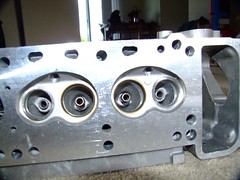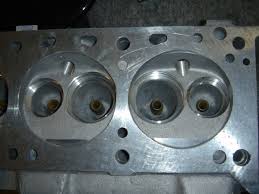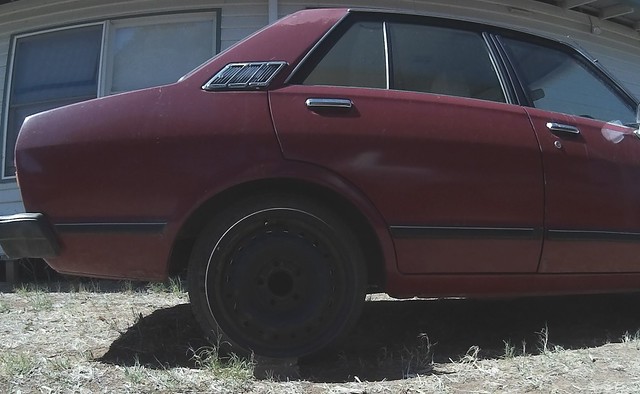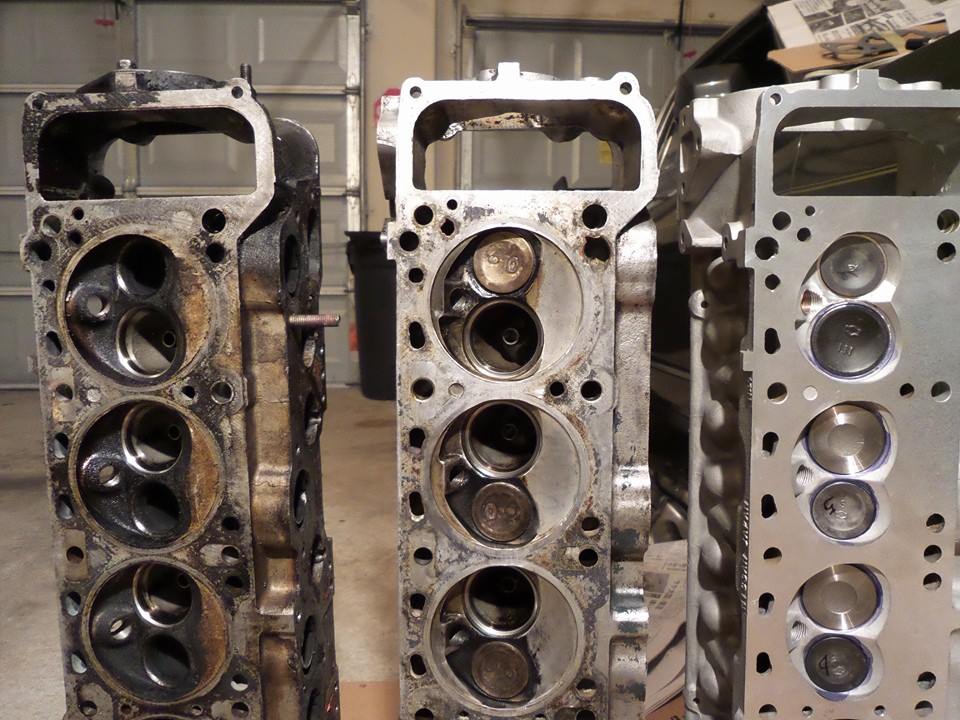Not much to show yet, but things are moving along, I will hopefully have this on the road before the big build-off starts May 1st, I will run it standard until the build-off is over so I don't get too distracted...
In the meantime been doing heaps of research on engines, gearboxes, diffs, brakes, seats, bodywork...etc...
Looks like I have fluked a good combination with the particular car I got and the spare engine I have in the backyard...
The spare engine as I have mentioned before is the taller deck, low compression L20b 2 litre from a 910 Bluebird, they are a good swap due to the direct bolt in and bigger capacity, also it brings with it the 5 speed box...
If you want to build it for a bit more power you need to get some more compression in it, usually this is done by either doing a full rebuild and swapping to flat top pistons or finding one of the increasingly rare 'supposedly' Japanese market only SSS "Peanut" closed chamber heads...
Here is a comparison of a closed chamber peanut and a open chamber standard L20b head (pics thanks to Google):
You can see why it results in higher compression...
I have been doing much research on finding a high compression head as the motor is still in good condition and not needing the expense of a rebuild just yet, they are available, but hard to find and expensive, in fact some people are welding on their stock heads to close the chambers up. so, hard to find, unless you happen to fluke one on a complete motor from someone who does not know what they have...
Or, due to Nissan/Datsun using up whatever left overs are around when building the last cars of a particular model, you may find your 'last of the run' Stanza already has a high compression closed chamber head, which just so happens to be what I did! The current motor has the W53 head, which according to
http://www.olddatsuns.com/html/tech/head_ID_2.htm will most likely be a "peanut" high comp head!
The other thing I wanted was a bit hotter cam, nothing too ridiculous, just enough for a lumpy idle and a bit more top end, started doing some research on what cam to get, and what rev range to aim for and decided on one designed for 3000-6500rpm, which would be plenty for a nice street-able car, checked out the recommended lifts and durations to accomplish that and went looking, turns out the cam used on the 1600 SSS uses the same specs, so that made it easier to find, so I could now search for that particular cam, turns out that item number is the same as the standard cam on 910 Bluebirds??? What???

How does that work? I ran the 910 motor before I pulled it and it was not lumpy at all... So that can't be right...
More Google-jitsu and head scratching and I happened upon the answer, yes they are the same cam, but due to the low compression of the L20b motor, it actually behaves very mild...
More questions asked, more answers found, and I am thinking well maybe that cam is not big enough then for a L20b? So I searched some Australian rallying sites and they all say use that cam, with a peanut head, and it gets a lumpy idle and the optimal revs is 3500-7500!

I guess that will do then!
So, when the time comes, I will pull the head off the L16 to confirm it is a high compression "peanut" and then drop it onto the L20b but switch in the L20b cam, a bit of match porting to the larger runners of the 2 litre intake and I should have a decent little engine!
A 32/36 Weber will more than likely get the job on top of the intake. I also have a twin Hitachi (SU copies) set up off a 180b SSS, but I have been reading that they are more trouble than they are worth. I would love a pair of sidedraft Webers, but that would just be asking for trouble if I ever get pulled over and the car inspected for legalities, at least the 32/36 Weber can be hidden under the factory air cleaner with some creative welding...
Next step was exhaust, the exhaust itself I figure I can manage ok with my tools, but I figured I would look at some headers/extractors in front of it to increase flow out of the motor. Went looking for suggestions on the Datsun forums and found that apparently the stock L16 cast exhaust manifold flows better than almost all headers and are tuned length, so armed with photos from the forum, I went looking at my motors to confirm if I had that manifold, turns out I do, in fact both motors have that exact manifold!

I was looking at a lightened flywheel as well but the forums also suggest this would be a mistake, as they are already fairly light and lightening them more makes it hard to match engine revs to gear speeds when shifting, it also makes they incredibly easy to stall with a hot cam apparently...
So, looks like I will be saving quite a bit of my intended budget from the motor build...

With that set-up it should result in around 140hp at the flywheel, which may not sound like much, but remember this car only weighs 900kg (>2000lbs) so it should be plenty to have some fun with! It is also probably approaching the limit of what the 910 gearbox can handle, and I don't what to shell out for a Z box...
I managed to find a local diff expert and asked him what diff and centre he would run out of the options I have, and he said that the RN20 Hilux with a late model LSD centre would be by far the best option, when I mentioned the possibility of changing to a Torsen centre he said don't bother, he can shim the standard LSD up as far as I want and in such a light car even the untouched LSD would be more than enough...

He also mentioned that if I ever decide to do a swap to a turbo Sr20 or something else, the Hilux diff should be good for 400+ hp in such a light car... Good to know I guess, but not planning on doing that...
I will probably stump up the money for the pre-made Mazda RX-7 front disc brake and 5 stud conversion, as it comes with an engineering certificate and so will make all the mods easier to get certified, the rear will probably be R31 Nissan Skyline callipers over EL Ford Falcon rear discs, there is no pre-certified option with the Hilux diff, but by using those particular parts the engineer will have a known basis for certifying them as they are a common conversion.
Only thing I have not sorted yet is re-setting the rear coil springs, they sit on top of the diff and the Hilux has bigger axle tubes, so it will raise the rear of the car. There are a few local shops who do spring re-setting and even the manufacturer who made the current lowered springs that are in the car can make custom lengths for reasonable prices. Cutting coils is not legal here, so I won't be doing that.
Think I will be going with 15" steel wheels from a Falcon too, then I can get the offsets changed cheaply to whatever will be needed to suit the car with all it's miss-matched pieces.
I happen to have a set of them here too, so that makes the decision that much easier!
Test pic:
Sorry for the long update, I know it is far more information than most will care about, but for those members who do want to know, the more detail, the better!
Luke.







 I guess that will do then!
I guess that will do then!





 with a 5 speed.
with a 5 speed.